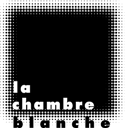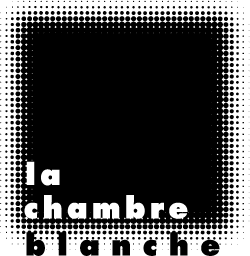Established in 1978, LA CHAMBRE BLANCHE is the first diffusion centre managed by a collective of artists in Quebec. Dedicated to all the visual arts’ disciplines, it programming has from its inception, focused mainly on performance, installation and alternative practices in photography.
Established in 1978, LA CHAMBRE BLANCHE is the first diffusion centre managed by a collective of artists in Quebec. Dedicated to all the visual arts’ disciplines, it programming has from its inception, focused mainly on performance, installation and alternative practices in photography.
LA CHAMBRE BLANCHE’s collective consists of artists and art critics whose coming together colors all of the centre’s activities. In 1981, a documentation centre emerges ; it will take off considerably from 1994 onwards. It is the only contemporary art documentation centre in Quebec City that offers a publicly available service, complete with research personnel, a welcoming venue and loan of documents.
Since 1982, the residency program has been a privileged space to think. The centre is seen as a pioneer and distinguishes itself by inviting artists to come and create ephemeral and unique works specific to this new context of creation within the framework of the site-specific residencies. In 1996, LA CHAMBRE BLANCHE changes radically its mandate in favor of this residency program. The organisation gets a well-appointed studio to welcome artists for six-week periods.The international presence intensifies and allows the centre to play a foreground role in Quebec’s cultural scene.
LA CHAMBRE BLANCHE is also well-known for the organisation of special events. Of the several thematic exhibitions in the 80s, of note are “Féministe toi-même, féministe quand même”, an exhibition, a symposium and a publication which brought together thirty artists and theoreticians. Let us also recall the event “Transatlantique”, which was organized in 1989 and 1990 with the French community of Belgium and to which participated Belgium artists who are now internationally known. In 1988, the year of its tenth anniversary, LA CHAMBRE BLANCHE organizes an important symposium on parallel galleries and its proceedings are still used as a reference today.
That same year, the centre moves to a new location and purchases the building in 1993. This turns out to be a significant choice: becoming part of a cultural neighborhood in the midst of development, providing the centre with autonomy and financial stability, and devoting the building to culture by renting studios out to artists at a cos-effective rate. Once again, LA CHAMBRE BLANCHE is seen as a pioneer in what would later become THE cultural district of Quebec City.
The early 90s are marked by a series of events that take place outside the centre which highlights its intentions to affirm its mandate and expand its activities to a larger public: ‘’Lèche-vitrine’’ in 1988, is shown in the windows on St-Jean Street, one of the busiest arteries of the city; in 1990, ‘’D’une marche à l’autre’’ takes place in the well-trodden stairs that link the upper and lower parts of Quebec City; ‘’À ciel ouvert’’ is shown in the Domaine Maizerets during the summer of 1991; ‘’Tous azimuts-Common Ground’’ in 1992-1993 is presented both in Toronto and Quebec City. In holding these events, the centre achieves two of its main objectives: to offer artists new contexts of production and to heighten awareness of a broader audience.towards contemporary practices.
In 1993, the project ‘’Chambres d’hôtel’’, which underlines the fifteenth anniversary of the centre, marks a definitive step in the evolution of these events. It bears witness to the maturity, the experience and the collective capacity of the centre to manage major events. The centre thus reaches its objective of participating to a critical discourse on art with an impeccable content, while reaching art enthusiasts as well as the general public. The impressive attendance confirms that the public of Quebec is an inquisitive, interested, and active supporter of culture. Adding to this is a regular programming of collaborating residencies where artists and authors question the link between art and writing about art.
In 1995, LA CHAMBRE BLANCHE publishes “Résidence 1982-1993”, the most important publication in its history and the only compilation to focus on artist residencies in Canada. The catalogue confirms the centre’s expertise in this area as well as in publishing.
In 1998, LA CHAMBRE BLANCHE celebrates its twentieth anniversary, the event’s theme is temporality. Besides the residency program, let us remember the collective projects such as Métronome as well as the first edition of the Rencontres internationales en arts visuels, which reunited artists who had been invited to create unique works on site, within the urban fabric of Quebec City. This event is part of a series of projects the chambre blanche offered its public during the last few years and that have marked its history. An important publication noting the activities realized for the twentieth anniversary was published to commemorate this occasion.
In 2000, a second edition of Rencontres internationales en arts visuels takes place under the theme of human communication – our relationships with each other. Nine site-specific projects are created across the city for this event.
Also in 2000, LA CHAMBRE BLANCHE welcomes a first Mexican artist, within the collaboration between the Conseil des arts et des lettres du Québec and the Fondo Nacional para la Cultura y Las Artes, from Mexico. At the end of the year, LA CHAMBRE BLANCHE opens a Web production laboratory thus proposing to the artist community, not only new production tools but also a new context of production ; the virtual realm. Starting in 2001, the first artists used it for Web production residencies.
In 2003 and 2004, an unbroken succession of activities underlines the twenty-five years of the organisation. Site-specific residences, Web residences, guest artists’ exhibitions and a series of conferences presenting the different aspects related to the act of giving, the chosen theme for the occasion.
In 2009, the centre launches its first electronic publication entitled «Le performatif du Web». The book is a theoretical essay questioning the notion of performative and trying to define it in the Web art context. Author Joanne Lalonde offers an exploration of works by artists Jillian Mcdonald, Jeanne Landry-Belleau, Linda Duvall, Michelle Teran, Nadine Norman and Patrice Duhamel, all of which have completed Web lab residencies in 2007 and 2008.
That year also witnesses the beginning of research residencies in LA CHAMBRE BLANCHE’s documentation centre. Authors, curators, art historians and artists are invited to foster interest for analysis and reflection using the archives as a research tool.
In 2009, LA CHAMBRE BLANCHE and incident.net join their efforts to create «Géographies Variables», a large crossed exchange program in network art between France and Quebec. These exchanges not only enrich Quebec’s City’s cultural landscape, but they contribute to the international influence of Quebec’s artists.
In 2012, the Symposium entitled à Signal_ questions network art technologies, expansion and insurrection. The Symposium brings together internationally renowned artists, art critics, curators and academics to discuss technologies linked to network art.
LA CHAMBRE BLANCHE gives a growing key place to broadcasting internal artistic projects in its programming. In 2010 an exchange program with Rad’Art cenrte emerges. Rad’Art is located in San Romano in a small village in the commune of Mercato Saraceno in Italy. The artist from Quebec is welcomed for a site-specific residency where he or she is invited to connect with the of the community’s denizens.
From 2010 to 2013, the centre welcomes Japanese artists through the prestigious Tokyo Wonder Site in Japan. The guest artists for these residencies were Yasuto Masumoto (2010), Takao Minami (2012) and So Kanno (2013).
In 2011, LA CHAMBRE BLANCHE initiates a collaboration of MIS (Museum of image and sound ) in Sao Paulo, Brazil. The digital art artists are invited to present a project within this residency exchange.
In 2014, the centre undertakes an exchange with Studio Let 777 in Dubrovnik, Croatia. The artists from Quebec carry out a site-specific residency work while being able to present that same project in other venues in the city of Dubrovnik, such as the Art Workshop Lazareti and Bukovac House.
During that same year, a new exchange program is created with the centre Transcultures in Mons, Belgium. This crossed exchange program involves the collaboration between a digital art artists and an artist/programmer to produces an art work to be presented during a major digital arts event. During the first exchange, the selected artists produced le projet «Lighthouses»which was presented in the Transnumériques event, the ‘’Festival des cultures et des émergences numériques’’ in Mons 2015, capitale européenne de la culture.( European capital of culture)
In 2014, Web laboratory gives way to laboratories. In addition to the computer assisted equipment (3D printer, CNC laser-cutting machine ), there is an electronics lab, a well-equipped computer park, virtual reality devices (Oculus Rift), movement sensing devices (Kinect, Leap Motion, Myo bracelet) as well as various peripheric electronic devices (Arduinos, RasberryPies, sensors, motors, etc.). These labs become the rendezvous for artists and makers thus allowing the centre to enter head-on the digital production field.

